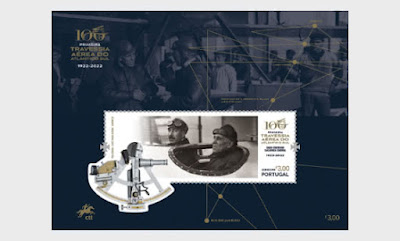2294) First South Atlantic Air Crossing, Portugal: Centenary Celebrations (1922-2022) Correios de Portugal or CTT (Portuguese Post) has issued a set of Stamps commemorating this feat by Portuguese Naval Aviators: Date/Year of Stamp set issue: 30.03.2022:
About The First South Atlantic Air Crossing, Portugal:
The First South Atlantic Air Crossing, flown by the naval aviators, Captain Gago Coutinho and Lieutenant Commander Sacadura Cabral, became a historical milestone thanks to the unifying social impact in Portugal and for its inherent value in historical, scientific and individual terms, despite the limited available resources.
In 1922, the completion of this Crossing, covering 4,367 miles in 60 hours 14 minutes, in a single-engine floatplane, was a remarkable feat, particularly due to this crew boldness and enthusiasm.
Nevertheless, it was the fact of having flown for 36 hours 29 minutes across the ocean, with no reference on the surface, maintaining a perfect awareness of their precise position mostly based on astronomical observations, which made this an unprecedented and innovative achievement at the time, and a forerunner of the autonomous air navigation.
Underlying this air mission, in addition to the detailed planning, the required knowledge, experience and scientific know-how for its successful completion, including new air navigation methods and equipment, such as the sextant adapted for inflight use and a heading corrector to enable quick calculations, must be highlighted.
The human component made a permanent mark on the three years of preparation and for the mission success, withstanding a succession of imponderables in which spirit of enterprise, willpower and tenacity were always present, even when seaplanes were lost and had to be replaced to complete the mission, thus achieving the established objectives.
The Stamp issue:
This stamp issue, which bears the mark of the Navy and Air Force Joint Commission "100TAAS" for the centennial commemorations, is based on the following trilogy: Men, Science and Machines.
The Souvenir Sheet, with symbolic logic, includes the planned route, the lines of which highlight the weather uncertainties, fuel consumption, the need for flexibility and opportune decision-making, differentiating between the fundamental and the incidental.
The First Day Cover (FDC) shows the flight route at left bottom. The Souvenir Sheet issued is affixed at top right, cancelled with a special cancellation stamp of Lisbon Post Office. The cancellation is dated - "30.03.2022".
Significant among take-off and ditching points are Cape Verde and Penedos – Saint Peter and Saint Paul Archipelago - the longest stretch that united Portugal and Brazil for the first time by air.
The sextant, depicted with great accuracy, recalls the dependence and importance of science during the crossing, as well as, these airmen's knowledge, know-how, creativity and skills.
These, captured for posterity in an expressive image, are shown in their flight positions, complementing each other as a crew, but being differentiated themselves in the pilot and navigator role.
Gago Coutinho, gazing into the distance, is lost in his own thoughts, internalising and assuming the responsibility of the mission, while Sacadura Cabral, looking straight ahead, inspires confidence and assurance in the success of the air crossing.
The richness of detail in the Stamp design, including the Crux constellation depicted in its relative position in the sky on that day and time in 1922, enhances the creative process.
The important take-aways:
Representing the First South Atlantic Air Crossing in a philatelic issue, on the occasion of its first centennial, adds value and meaning to the event, continuing to highlight Gago Coutinho’s sextant as a symbol of knowledge, know-how and the astronomical air navigation art, made possible, adequate flexible by mathematically rigorous processes and methods created or perfected by the Portuguese.
The individual stamps represent the three “machines” flown by the aviators.
The first, which took off from Lisbon at the break of dawn on 30 March 1922, is the Fairey IIID, Mark II, F400, identified by the manufacturers as a Transatlantic Load Carrier, and which, by government decree, become the Lusitânia.
The second is the Fairey IIID, F 401, number 16, dead in water on 11 May, after an emergency alight requiring assistance from a cargo ship, the Paris City.
The third is the Fairey IIID, F402, number 17, which completed the crossing on 17 June, later christened Santa Cruz in Brazil.
A First Day Cover (FDC) bearing the individual cancelled stamps at right.
A Special Folder (SF) bearing the Cancelled Stamps (S) and Souvenir Sheet (SS), and giving a description of the flight.
Technical details:
Issue Date:30.03.2022
Designer: Folk Design (Paulo Alegria)
Printer: Cartor
Process: Offset
Size:
Stamp Size: 0 x 30,6 mm,
S/S Size: 125 x 95 mm
Values: S/S - 3.00g S - I20.00g (x 3 Stamps)
Interesting links to posts on Portugal and Spanish Coins and postage stamps on this blog:





Santosh Khanna has commented:
ReplyDelete"Thanks for sharing this informative post."
Thank you so much, Khanna sahab.
Delete